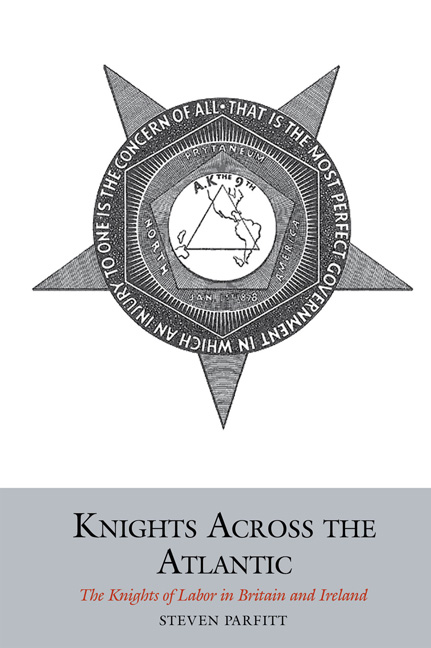Book contents
- Frontmatter
- Contents
- Acknowledgements
- Introduction: The World of the Knights of Labor
- 1 Origins
- 2 The Rise of a Transnational Movement
- 3 Organisation, Culture and Gender
- 4 The Knights in Industry
- 5 The Knights and Politics
- 6 The Knights and the Unions
- 7 The Fall of a Transnational Movement
- Conclusion: The Knights of Labor in Britain and Ireland
- Appendix: List of Known Assemblies of the Knights of Labor in England, Scotland, Wales and Ireland
- Bibliography
- Index
1 - Origins
- Frontmatter
- Contents
- Acknowledgements
- Introduction: The World of the Knights of Labor
- 1 Origins
- 2 The Rise of a Transnational Movement
- 3 Organisation, Culture and Gender
- 4 The Knights in Industry
- 5 The Knights and Politics
- 6 The Knights and the Unions
- 7 The Fall of a Transnational Movement
- Conclusion: The Knights of Labor in Britain and Ireland
- Appendix: List of Known Assemblies of the Knights of Labor in England, Scotland, Wales and Ireland
- Bibliography
- Index
Summary
At the end of 1881 the potters of Staffordshire went on strike; in 1882, they returned to work defeated. The potters had called that action to force their employers to participate in the formal arbitration and conciliation machinery that had governed the pottery industry until the end of the 1870. Their local unions emerged from the defeat in poor shape, and the potters’ leaders decided that if they wanted to restore arbitration to their industry they needed a single, strong union that could negotiate on their behalf from a position of strength. When they met at Hanley to establish that union, the National Order of Potters, in September 1882, the potters emphasised their desire to break with the ineffective unions of the past by basing their new organisation on a model sourced from abroad. The newspapers all agreed that ‘this new Trades Union shall be based upon principles in many respects similar to those of the new American Trade Organisation, known as the Knights of Labour.’
The press could be forgiven for thinking that the Knights, already 13 years old, were in fact a new movement. Their leaders had only recently made the name and existence of their order public, and the Knights of Labor only became widely known in the United States, let alone elsewhere, two or three years later. In this context the decision of the Staffordshire potters to imitate an obscure American fraternal order becomes only more significant. The American pottery industry, writes Frank Thistlewaite, was ‘the result of a direct colonization from the Five Towns of Staffordshire.’ Potters routinely migrated back and forth across the Atlantic. Ties of kinship and friendship spanned the ocean too. When potters in Pennsylvania, New Jersey and Ohio became early recruits of the Knights of Labor, their colleagues in Staffordshire soon heard of it. After their local unions were smashed in the strike of 1881–82, the Staffordshire potters naturally turned to the Order of their American cousins as the model for their own new union.
The Staffordshire potters kept unusually well abreast of developments within the American labour movement, and were not representative of British and Irish workers as a whole.
- Type
- Chapter
- Information
- Knights Across the AtlanticThe Knights of Labor in Britain and Ireland, pp. 20 - 49Publisher: Liverpool University PressPrint publication year: 2016



